Content
- 1 What powdery mildew looks like on roses
- 2 Reasons for the appearance
- 3 Why is powdery mildew dangerous?
- 4 How to process and how to get rid of powdery mildew on roses
- 5 How to treat a room rose from powdery mildew
- 6 Downy mildew control measures
- 7 Disease prevention
- 8 Conclusion
Powdery mildew on roses is the most common fungal disease of this culture. It causes serious damage to the plant and can cause death if not treated promptly. But not all gardeners know how to recognize the first signs of damage, and what to do in this case. Therefore, you should familiarize yourself with the features of a fungal disease, find out what drugs will help save roses from powdery mildew, and also what preventive measures reduce the likelihood of the appearance on roses.
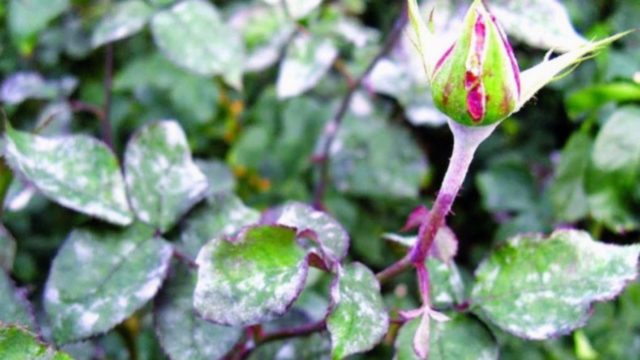
Fungal disease prevents full flowering and shrub development
What powdery mildew looks like on roses
The disease can be recognized by the white bloom, which is the sporulation of the fungus. When erased, it remains on the fingers, and at the same time there is an unpleasant herring smell. Initially, powdery mildew appears on the upper side of the leaves in separate spots. Subsequently, they grow and merge into a single whole.
In the presence of favorable conditions, the disease progresses actively and eventually spreads. In addition to leaves, it affects the shoots and buds of the rose. After the maturation of the spores, small drops appear on top of the plaque, which fully justifies the name of the disease.
Subsequently, the white bloom turns dirty gray and then brown. And on the affected areas of the leaves and shoots of the rose, small spore balls of dark brown color appear.
What is the difference between powdery mildew and false
Downy mildew is also a common fungal disease of roses (pictured below). At the initial stage of development, it can be recognized by yellow-green rounded or angular oily spots, which are limited by leaf veins. On the reverse side of the plates, a violet-gray coating appears in this place.
As a result, the lesions grow and merge into a single whole. Downy mildew is characterized by a rapid development process. And if yesterday the rose bush looked quite healthy, today it may already look depressing.
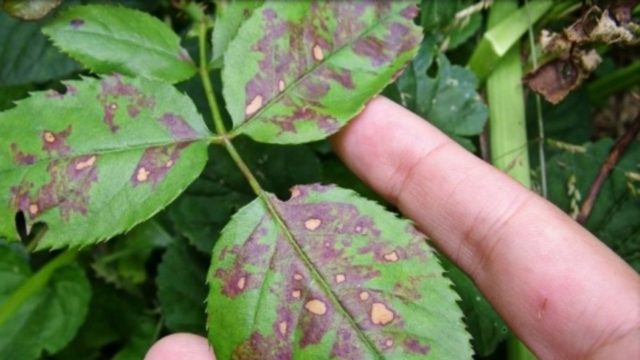
Without treatment, the rose can die from downy mildew.
Reasons for the appearance
The causative agent of the disease is the powdery mildew Sphaerotheca pannosa, as a result of the active sporulation of which the leaves, buds and shoots of the rose are covered with mycelium. It appears in the form of a thick white bloom, which fully justifies the name. The pathogen hibernates in microcracks on the stems and under the scales of dormant buds. With the arrival of spring heat, the fungus begins to actively develop.This is facilitated by a temperature of + 25 ° C and higher in combination with a humidity in the range of 70-90%.
However, the disease can develop in the event of prolonged drought. During this period, the leaves of the rose lose their turgor, which promotes the penetration of the haustoria of the fungus into the plant tissue. Therefore, watering and a constantly slightly moist substrate are the main conditions for the prevention of this disease.
Provoking factors for the development of powdery mildew on roses:
- Long rains followed by warm weather. These conditions contribute to the active evaporation of moisture from the soil.
- Sharp changes in day and night temperatures.
- Closely planted rose bushes. Insufficient ventilation contributes to the active reproduction of the fungus.
- Failure to comply with the feeding schedule. Excess nitrogen in the soil leads to an excessive build-up of green mass, which weakens the immune system.
- Heavy soil. This leads to the fact that the access of air to the roots of the rose is disrupted. Against this background, the plant is not able to fully assimilate nutrients.
The purchase of an infected seedling can also cause the development of powdery mildew in the rose garden. Therefore, before planting a new bush, it is necessary to initially treat it with fungicides that are effective against this disease. This will minimize the risks.
Why is powdery mildew dangerous?
Powdery mildew is a disease of roses, which not only leads to a lack of flowering, but can also cause the death of a shrub. The development of the fungus interferes with photosynthesis in the leaves. Against this background, metabolic processes in tissues initially slow down, and then completely stop. This leads to deformation of leaf plates, shoots, buds, roses.
As a result of further progression, there is a drying out of the affected areas, premature leaf fall. This leads to a deterioration in the decorative effect of the rose. In addition, powdery mildew significantly weakens the shrub's immunity, which negatively affects its frost resistance.
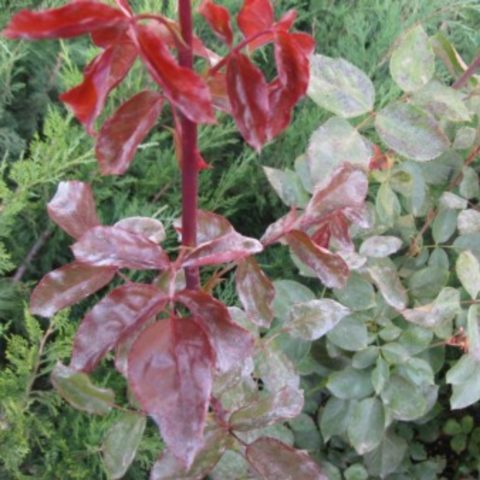
Not all powdery mildew weakened bushes are able to survive the winter.
How to process and how to get rid of powdery mildew on roses
The white bloom that appears on the leaves only initially looks harmless. But powdery mildew on roses must be fought immediately at the first signs of defeat, so as not to waste time and prevent mass spread to all bushes. To do this, you can use professional and folk remedies that can successfully complement each other. But it should be understood that the treatment of powdery mildew on roses should be complex, since one treatment is not able to solve the problem.
The best remedies and preparations for powdery mildew on roses
There are a number of chemical and biological agents that can effectively combat disease in the bush. They act in direct contact with the pathogen, and can also penetrate the tissues of the plant, spreading throughout the entire part.
Colloidal sulfur
This drug has been proven to be effective against powdery mildew on roses over the years. It is characterized by a contact action, therefore it requires uniform spraying of all parts of the shrub.
The treatment of roses from powdery mildew with colloidal sulfur must be carried out at a temperature not lower than + 20 ° С, but not higher than + 35 ° С. In the first case, its effectiveness decreases, and in the second, the active component can cause burns on the leaves. To prepare a working solution, add 30 g of powder to 10 liters of water.
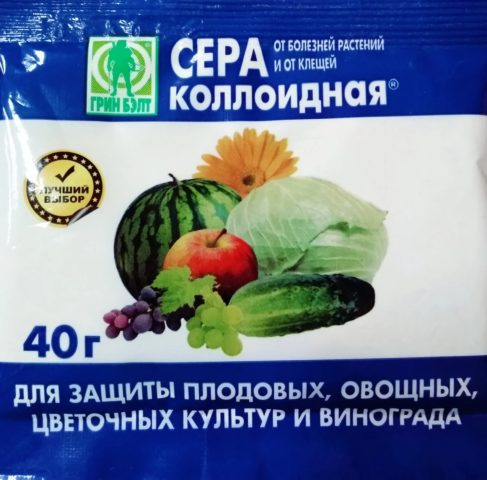
Colloidal sulfur cannot be combined with other preparations in the same tank mixture
Tiovit Jet
Sulfur-containing preparation, in which the mass fraction of the active component is about 80%. The agent is effective at the initial stage of the lesion, since it has a contact effect.To get rid of powdery mildew, it is necessary to sprinkle the roses with the working solution of the preparation, evenly wetting the parts of the shrub. To prepare it, you need to add 30 g of the product to 10 liters of water.

Temperature range of Tiovit Jet application is + 20-35 ° С
Speed
A chemical preparation of contact-systemic action, the active substance of which penetrates into plant tissues and provides comprehensive protection. It can be used to combat powdery mildew on home and garden roses. To prepare a working solution, add 1.6 ml of the product to 8 liters of water.
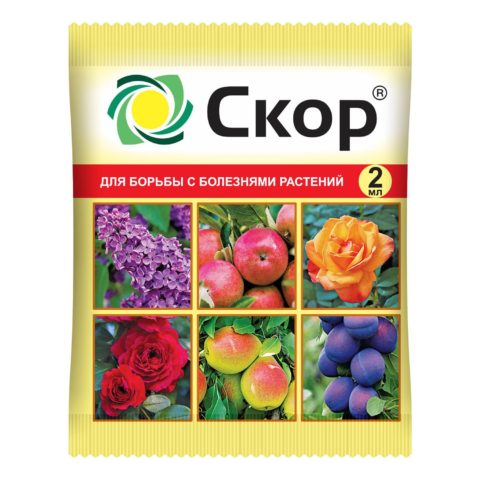
The drug Skor begins to work 2 hours after treatment.
Topaz
A chemical preparation of systemic action, which ensures high efficiency of its use against fungus. The active ingredient initially inhibits sporulation, and then causes the death of the pathogen. The duration of the fungicide protection against powdery mildew on roses is 10-14 days. For the treatment of rose bushes, it is necessary to dissolve 2 ml of the drug in 5 liters of water.
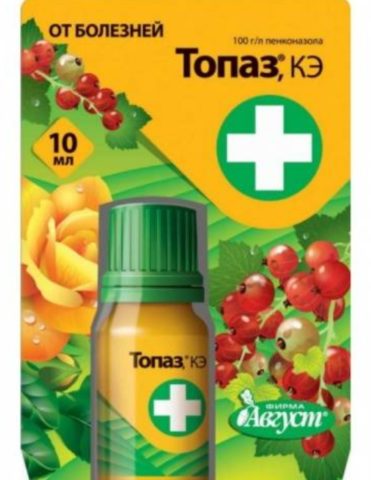
When processing with Topaz, there is no need to wet all leaves and shoots
Fitosporin-M
A biological product that is able to cure a rose from powdery mildew at the initial stage of the lesion. Its basis is the culture, the waste products of which suppress the sporulation of the fungus. The drug has a systemic effect, therefore it penetrates into all parts of the plant. Fitosporin-M is a safe drug that can be used safely even in an apartment. To prepare a working fluid, dissolve 1.5 g of powder in 1 liter of water.
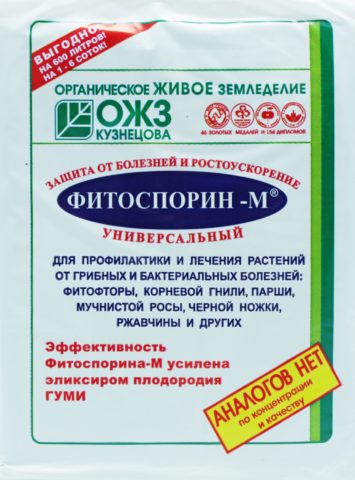
It is necessary to dilute the biological product Fitosporin-M 2 hours before use.
Folk remedies for powdery mildew on roses
This method of combating fungal disease can be used at the initial stage of the lesion. To prepare effective products, you can use components that are present in every home. Folk measures to combat powdery mildew on roses can also be used as a prophylaxis.
But it should be understood that with a massive spread of the disease, this method of treatment is not able to stop the disease, therefore, in such cases, it is necessary to use chemical preparations.
Baking soda
To prepare an effective product, you need to pour 50 g of this component into 5 liters of warm water. Then grate 30 g of laundry soap and add to the mixture as well. Then stir until a homogeneous composition is obtained. Apply a product to evenly spray the bushes. Repeat treatment with soda powdery mildew on roses every 10 days until the shrub is fully restored.
Milk serum
To prepare the working solution, it is necessary to collect 5 liters of water in a separate container. Add 1 liter of whey and 10 drops of iodine. Mix everything thoroughly. And in order to improve adhesion, you need to add an additional 30 ml of dish detergent. Apply the mixture to spray the bushes immediately after preparation. Repeat therapy every 10-12 days if necessary.
Wood ash
An extract based on this component has a healing effect. This will require 20 g of wood ash, pour 1 liter of boiling water, cover and leave for 12 hours. At the end of the waiting period, clean the mixture. Apply the resulting concentrate in a ratio of 1:10 with water. If a rose is sick with powdery mildew, then treatment should be done every 7 days until the signs of the disease completely disappear.
What to do if powdery mildew on rosebuds
If signs of the disease appear at the stage of preparing the shrub for flowering, then you need to act quickly. However, given that chemical agents during this period can cause deformation of the buds and lead to burns, biologics should be preferred.
In this case, it is recommended to use Fitosporin-M against powdery mildew on roses.It has a gentle effect, so you can use it without fear.

Safe drugs should be used to treat a room rose.
How to treat powdery mildew on roses in summer
During this period of the year, the fungus begins to progress and can spread to all rose bushes in the garden. Therefore, chemical control agents should be used. It is desirable to carry out the treatment every 10 days, alternating preparations. The most effective of them: Skor, Topaz. And between the main treatments, folk remedies can be used.
How to treat roses from powdery mildew in autumn
During this period of the year, the shrub is already preparing for the winter. Therefore, it is recommended to use sulfur-containing products in the fall. They help fight the pathogen of powdery mildew on the shoots of the plant. To spray roses from powdery mildew in the fall should be colloidal sulfur and the drug Tiovit Jet.
How to treat a room rose from powdery mildew
To treat the plant at home, preference should be given to safe control measures. Therefore, first of all, you need to use folk remedies. If the disease continues to progress, then Fitosporin-M should be used. In case of mass destruction, it is worth using Speed, but only in a well-ventilated area.
Downy mildew control measures
In order for the treatment to be effective, it is necessary to adhere to some recommendations. Otherwise, therapy may not bring the desired result and harm the plant.
Basic Rules:
- Before processing, you must initially remove all affected leaves and shoots, since they will not be able to recover, but will only be a source of infection.
- Do not spray roses after watering or rain. In this case, the leaves are not able to absorb the solution to the full, so the treatment will not be effective.
- When using folk remedies and contact drugs, it is necessary to evenly spray the shoots and leaves on both sides, otherwise it will not be possible to completely get rid of the fungus.
- To save a room rose, you need to not only spray the aerial part, but also replace the top layer of soil in the pot. After all, it is there that the colonies of mushroom mycelium are concentrated.
- You need to fight the disease regularly. Therefore, the treatment of the bushes should be repeated every 7-14 days until the symptoms disappear completely. For prevention, you need to spray roses once a month.
- The working solution should be prepared immediately before its use, since it loses its effectiveness during storage.

It is important to process bushes in dry, calm weather.
Disease prevention
Following simple rules for caring for roses can reduce the likelihood of developing powdery mildew. They are highly effective and do not require complex steps.
Preventive measures:
- periodically inspect the bushes;
- carry out feeding taking into account the stage of development of the rose;
- spray plants with fungicides and folk remedies 1 time in 2-4 weeks;
- prevent the root system from drying out;
- loosen the soil after watering and rain;
- remove weeds in a timely manner.
Disease resistant rose varieties
Some shrub species are more susceptible to powdery mildew. Therefore, in regions with difficult climatic conditions, varieties showing resistance to this disease should be grown.
These include the following types of roses: Lady of Shalott, Aphrodite, Galaxy, Aspirin Rose, Cadillac, Westerland and Gold Spice.
Conclusion
Powdery mildew on roses is a dangerous disease that must be fought constantly. Therefore, increased attention should be paid to prevention, and if signs of damage appear, do not hesitate with treatment. In the absence of timely protection measures, the disease can spread to the entire rose garden and nearby crops. Then it will be much more difficult to cope with it.








